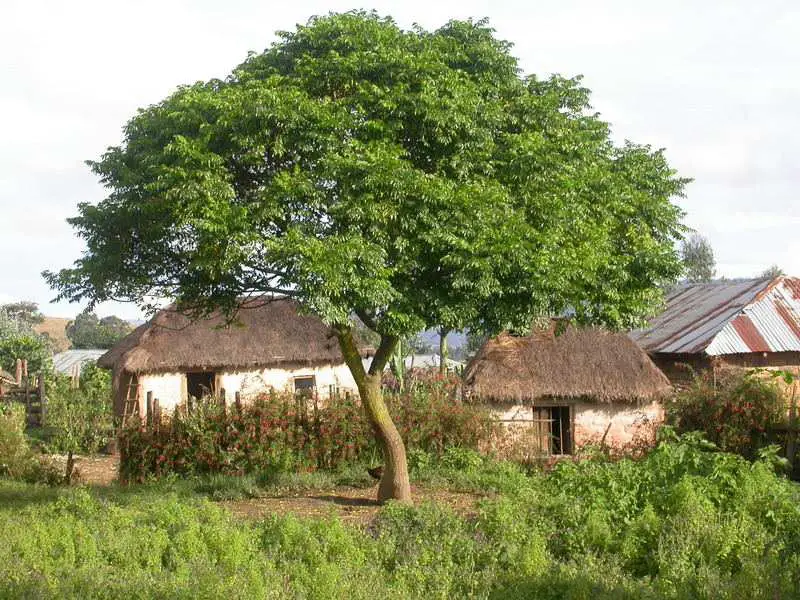
Image – inner path
The neem tree is an extraordinary plant that has interesting medicinal and insecticidal properties. In addition, it is a very interesting garden tree, since it provides a pleasant shade. But, what is it like and what care does this magnificent plant require?
Time to find out. Discover with us all the secrets of the neem tree and don’t wait any longer to enjoy this beautiful plant.
Origin and characteristics of the neem tree

Image – Wikimedia / Kevinsooryan
Our protagonist is an evergreen tree whose scientific name is Azadirachta indicatesand which is much better known by the common names nim, neem margosa or Indian lilac. Native to India and Burma, has a rapid growth rate reaching 20 meters in heightbeing able to exceed 30. The crown is wide, up to 20m in diameter. the leaves are very reminiscent of the Melia sourach: they are pinnate, with the leaflets up to 5cm and less than 0,5cm wide.
The flowers are white and fragrantand are grouped in branched inflorescences. Once they are pollinated, the fruit begins to ripen, which is an olive-like drupe measuring 14 to 28mm in length and 10 to 15mm in width. The seeds measure 1cm, and are brown in color.
How do you take care of yourself?
If you want to have one or more copies, here is how to take care of it:
Location
The neem tree is a plant that it has to be outside whenever possible, in full sun. But this will change if frosts occur in winter, since in these conditions it will be necessary to protect it preferably in a heated greenhouse, or at least in an interior patio or in a bright room without drafts until temperatures improve.
Even if only weak and punctual frosts are registered, wrapping it in an anti-frost fabric and putting padding on it to protect its roots can be more than enough for it to survive.
Land

Image – Wikimedia Commons / Wikimedia Commons
- the garden: it is not demanding, but it must have good drainage and be rich in organic matter.
- Flower pot: fill with quality universal substrate (for sale here!).
Irrigation
Irrigation must be frequent. It will depend on the climate and the location, but in general it will be necessary to water every 2-3 days in summer, and every 4-5 days the rest of the year. It is important that, every time it is watered, the soil remains very moist but without overdoing it; that is to say, it is not necessary to get to the point of waterlogging, but neither is it necessary to leave a dry part.
For this reason, you have to add water until you see that the soil is wet, or until it comes out through the drainage holes if you have it in a pot. Avoid wetting the leaves so they don’t burn.
Subscriber
During the warm months it is advisable to pay it regularly with Organic fertilizers, such as vermicompost or manure. It must be borne in mind that a correctly fertilized plant will have a strong immune system, capable of fighting against microorganisms that cause diseases.
Planting or transplanting time
In springor after the dry season if you live in an area with a tropical climate.
Multiplication
The neem tree multiplies by seeds in spring (or after the dry season 🙂), following this step by step:
- First, put the seeds in a glass of water and keep them there for 24 hours. In this way, you will be able to know which are the viable ones (they will be the ones that sink), and which ones are not.
- After that time, fill a seedbed (it can be a flowerpot, a seedling tray, milk containers, … or anything else that is waterproof and that has or can have holes for drainage) with soil for seedlings (for sale here!), universal substrate or, compost mixed with 30% perlite (for sale here!).
- Then, water and place the seeds on the surface of the substrate, ensuring that they are separated from each other. In fact, if the pot for example measures about 13cm, the ideal is not to put more than two seeds since they are plants that germinate well and grow fast.
- Next, sprinkle sulfur or spray with fungicide to prevent fungus.
- Finally, place the seedbed outside, in semi-shade.
Keeping the substrate moist but not waterlogged, they will germinate in about 15 to 20 days.
Rusticity
Due to its origin, can’t stand cold or frost. It is only grown outdoors all year round in the tropical and subtropical regions of the world.
What is neem used for?

Ornamental
It is a very decorative plant and quite easy to care for, which provides a very nice shade. Also, like other trees with a wide and / or dense crown, it serves as a refuge for birds and some insects, which is a perfect excuse to give more life to the garden.
Medicinal
Its medicinal properties are without a doubt what makes it such a popular plant. It’s known that is effective against scabies, lice, nematodes and worms that affect human beings.
Neem tree properties
From the neem tree practically everything is used:
- Leaves and seed oil: they have antiseptic, antherminic and antiparasitic properties.
- Cortex: it is stimulating, vermifuge, astringent and febrifuge.
- Fruit: it serves as a purgative, but in high doses it is toxic.
Uses in gardening
- As a biocide: it is mixed with urea, and helps to eliminate termites, nematodes, most common pests (Red spider, aphids, etc.) as well as, it also serves to fertilize the soil a little. You can even buy the product already made, from here!.
- Against desertification: When you have the garden in a place at risk of desertification, it is advisable to plant a neem tree to prevent it.
Did you find it interesting?

